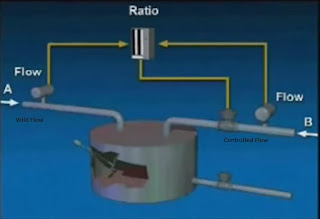Ratio Control
In Ratio Control, the controlled variable is the ratio of two measured variables. Control is effected by adjusting one of the variables – the controlled variable, to follow in proportion to a second – the wild variable. The proportionality constant is the ratio.
Ratio relays are nothing more than manually adjustable gain devices and the ratio setting is the true set-point of the system. If the flow measurements are with differential pressure transmitters, the actual linear ratio setting must be the square of the required ratio. Most ratio relays have optionally calibrated scales which allow direct setting of the required ratio.
Ratio Control often monitors processes that require mixing one material in proportion to another.
For example, the product may require one part of material A for every two parts of material B.
With ratio control one of the materials flows at the rate required by other parts of the process.This is known as the wild flow. The flow rate of the second,called the controlled flow could be adjusted by a ratio controller.
The ratio control loop uses the rate of the wild flow to determine the rate of controlled flow so that the materials are mixed in the appropriate ratio.
Ratio control loop has one sensor and transmitter in the wild flow and another set in the controlled flow.Both sensors transmit signals representing the respective flow rates to the ratio controller.
The controller maintains the flow rate of the the controlled flow at a ratio to the wild flow.
The desired ratio is set by adjusting ratio the setpoint. Ratio control then monitors the value of one variable and sets the value of the second variable at a specific ratio to the first.






